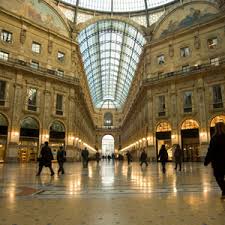Friday, February 25, 2011
Italy!Milan!
Milan is Heaven on Earth for shopping lovers. You can find the best of everything in this city, especially everything connected with fashion and design. Milan has a wonderful history as a laboratory of creative ideas: The Polytechnic and the Accedemia di Brera have trained fashion designers and other designers who are famous worldwide. They exhibited their creations for the first time in Milan, often creating scandal and revolutionizing fashion with their own personal style, never going unobserved. Armani, Versace, Prada, Dolce & Gabbana, Pucci, Gucci and many more took off on Milan’s runways. Fashionistas make a pilgrimage here to shop at the designers’ flagship stores in the Quadrilatero d’Oro (Golden Quad). Boutiques stocking emerging labels, and chic concept shops also line the city’s streets, while discount outlets selling samples, seconds and last season’s cast-offs are a bargain-hunter’s Holy Grail. Milan is also the world capital of furniture and homewares (the beanbag is a Milanese brainchild), and a hub for risk-taking contemporary art. By night there’s an avant-garde theatre scene, a fabulous aperitivi scene (extended ‘happy hour’ with platters of bar food laid on) and hip, hot clubs. Fashion and finance aside, Milan’s other religion is, of course, calcio (football). The city is home to both AC Milan and Inter, two of Italy’s top teams, and passionate crowds pack San Siro stadium on Sunday in season. The city also harbours some lesser-known attractions such as the Navigli’s canal-side cafés and old-fashioned gelaterie (ice-cream shops) and the funky design district of Isola.

Thursday, February 17, 2011
Italy! Tuscany!
Tuscany! Tuscany is one of twenty regions in Italy. The region is located in the central, western part of the country, north of Rome and south of Genoa. It is bounded by the Apennine Mountains to the North and East, the Apuan Alps on the northwest and by the Tyrrhenian Sea on the West.Tuscany is a medium-sized region which can be crossed in a few hours. The Major cities in the region are Florence, Pisa, and Siena. Tuscany is one of the greatest repository of art in the world, from extraordinary paintings and sculpture to frescoes and architectural masterpieces. Visitors to Tuscany come for many reasons. Many come in search of fine art, others to explore the extraordinary countryside. Gourmets and wine buffs descend on Tuscany to enjoy the simple yet wonderful cuisine and wine. Walkers enjoy the mountain paths, cyclists the rolling hills, summer vacationers the sea coast and islands. Students come to learn the beautiful Italian language and culture. There is a lot to see and do in Tuscany, the difficulty is really where to start. The more you come to know the region, the more extraordinary Tuscany appears. Tuscany houses many museums with masterpieces by the greatest artists of all time, from Leonardo da Vinci and Michelangelo, to Botticelli, Giotto and Donatello. Depending on your interests in history, art or sculpture - Tuscany has it all, spanning across time, styles and periods. It you love fashion then Italy is the place to go because they have one of the best fashion schools in Europe. There are many ways to get around the region of Tuscany: bus, bike, car, and train.
Friday, February 11, 2011
Italy! Sistine Chapel!
The Sistine Chapel is in Vatican City. The Sistine Chapel was commissioned by Pope Sixtus IV, from whom it derives its name, in 1475. It was designed to be - and still is - the pope's chapel and the site of papal elections. The Sistine Chapel was consecrated and dedicated to the Assumption of the Virgin on August 15, 1483. Michelangelo was asked to paint the Twelve Apostles and a few ornaments on the ceiling of the chapel. But as he began work on the project, Michelangelo conceived grander designs and ended up painting more than 300 figures. He worked on the project between 1508 and October 31, 1512, in cramped conditions high on a scaffolding and under continous pressure from the pope to hurry up. The project would permanently damage the artist's eyesight. Michelangelo was in his 60s when he was called back to the chapel, again against his wishes, to paint The Last Judgment on the altar wall. The work was commissioned by Pope Clement VII shortly before his death, and Clement's successor, Pope Paul III Farnese , forced Michelangelo to complete it quickly. It was the largest fresco of the century and is still an unquestioned masterpiece. The Sistine Chapel was originally divided into two equal sections, a nave for the laity and a presbytery for the clergy, by a marble screen and the pattern of floor mosaics. In later years, the screen was moved to make the nave smaller and the presbytery much larger. The walls are decorated with frescoes by Renaissance masters and are divided into three horizontal levels.
Italy! Gondolas!
A way to get around in Venice is by taking a gondola ride. A gondola is flat and made of wood. It's 11 meters long, weighs 600 kg and is hand built in special workshops called squeri of which there are still a few today. Gondolas are seen in festival parades and in regate or rowing competitions. Taking a ride through the canals of Venice can be very romantic. A gondola is like a luxury car. Although black is the official color, many are ornately decorated and have comfortable seats and blankets. You can stroll around and look for one that suits your fancy. While gondolas were once regularly used by Venetians, especially of the upper classes, today vaporetti have become the main form of water transportation in Venice. A couple hundred years ago there were about 10,000 gondolas but today there are only about 500.
Subscribe to:
Posts (Atom)